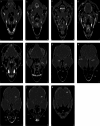Computed Tomographic Anatomy of the Head in Cockatiel (Nymphicus hollandicus)
- PMID: 39876619
- PMCID: PMC11775382
- DOI: 10.1002/vms3.70234
Computed Tomographic Anatomy of the Head in Cockatiel (Nymphicus hollandicus)
Abstract
Background: Nowadays, computed tomography (CT) scanning is one of the most practical and precise diagnostic imaging methods that can be utilized to evaluate the head in birds.
Objectives: This study aimed to present the normal anatomical data of the head of the cockatiel (Nymphicus hollandicus) using the CT method. In this research, the features of this bird's head were investigated in terms of bones, joints, muscles, sinuses and other constituent tissues.
Methods: The current retrospective cross-sectional study used carcasses of six adult cockatiels (Nymphicus hollandicus) (three males and three females) with an average age of 1-3 years and an average weight of 75-110 g. After preparing the CT images, the head of each parrot underwent gross anatomy studies.
Results: Based on the results, reconstructed CT images could identify most structures of the cockatiel (Nymphicus hollandicus) head. Parietal, mandible, occiput, maxillary, premaxillary, palatine, pterygoid, quadrate, temporal bones, epithelial membranes, external ear canal and bony labyrinth, ossicles and entoglossal bones, different parts of the infraorbital sinus, brain hemispheres and various parts of the eyeball and conchae of the nasal cavities were examined in CT images. The results related to the CT evaluation and anatomical examination of the cockatiel (Nymphicus hollandicus) head demonstrated a high correlation.
Conclusion: The results of this research can be employed as a reference and a suitable atlas for identifying anatomical features, examining different species of the cockatiel (Nymphicus hollandicus), teaching anatomy and interpreting CT scan images, as well as performing clinical examinations and treating this type of parrot.
Keywords: anatomy; cockatiel (Nymphicus hollandicus); computed tomography; head.
© 2025 The Author(s). Veterinary Medicine and Science published by John Wiley & Sons Ltd.
Conflict of interest statement
The authors declare no conflicts of interest.
Figures




References
-
- Al‐Rubaie, N. I. , and Kadhim K.. 2023. “Anatomical Comparison of the Nasal Cavity in Adult Male and Female Cockatiel (Nymphicus hollandicus).” Acta Biomedica 94: 2023719. 10.23750/abm.v94i3.13443. - DOI
-
- Carril, J. , Tambussi C. P., and Rasskin‐Gutman D.. 2021. “The Network Ontogeny of the Parrot: Altriciality, Dynamic Skeletal Assemblages, and the Avian Body Plan.” Evolutionary Biology 48: 41–53. 10.1007/s11692-020-09522-w. - DOI
Publication types
MeSH terms
Grants and funding
LinkOut - more resources
Full Text Sources
Medical

